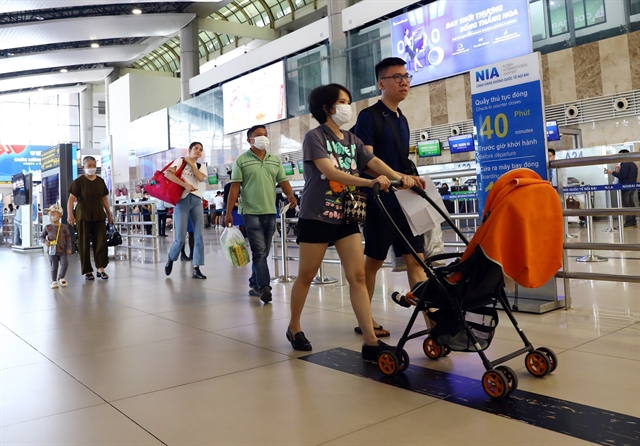 Economy
Economy

 |
| Passengers at Nội Bài International Airport. The country needs VNĐ420 trillion (US$18 billion) to develop its airport system by 2030. — VNA/VNS Photo Huy Hùng |
HÀ NỘI — Việt Nam is set to have 33 airports by 2030, including 14 serving international flights and 19 serving domestic flights.
The investment is estimated at about VNĐ420 trillion (US$18 billion), mobilised from the State budget, non-budget capital and other legal capital sources.
This information was released after Deputy Prime Minister Trần Hồng Hà on Wednesday signed Decision No 648/QĐ-TTg on the national airport system planning.
The 14 international airports are Vân Đồn, Hải Phòng, Nội Bài, Thọ Xuân, Vinh, Phú Bài, Đà Nẵng, Chu Lai, Cam Ranh, Liên Khương, Long Thành, Tân Sơn Nhất, Cần Thơ and Phú Quốc.
The 19 airports serving only domestic flights are Lai Châu, Điện Biên, Sa Pa, Cao Bằng, Nà Sản, Cát Bi, Đồng Hới, Quảng Trị, Phù Cát, Tuy Hòa, Pleiku, Buôn Ma Thuột, Phan Thiết, Rạch Giá, Cà Mau, Côn Đảo, Biên Hòa, Thành Sơn and the second airport in the south of Hà Nội.
Under the decision, the country would develop the airport system in a synchronous and modern direction, to meet the demand for transportation and extensive international integration; protect the environment; save resources; ensure national defence and security; improve the economy’s competitiveness, contributing to turning Việt Nam into a developing country with modern industry and high middle income by 2030.
Under the newly approved planning, the total number of passengers through airports would be about 275.9 million by 2030 (accounting for 1.5-2 per cent market share of traffic transport and 3-4 per cent of total intercity passenger transport volume).
The total volume of cargo through airports is expected to be about 4.1 million tonnes (accounting for 0.05-0.1 per cent market share in transportation).
In terms of infrastructure, the master plan prioritises investment in a number of large airports, which play a key role in the Hà Nội (Nội Bài International Airport) and HCM City (Tân Sơn Nhất and Long Thành International Airports). The country would gradually upgrade and effectively exploit existing airports, continue to research and invest in new airports to increase the total designed capacity of the airport system to meet about 294.5 million passengers. It is striving to ensure over 95 per cent of the population is able to access airports within 100 kilometres.
The infrastructure and flight management equipment would be invested to meet transportation needs. The country would invest in logistics centres, training centres, flight training, aircraft maintenance and repair systems to ensure flight operations.
In addition, logistics centres will be arranged at airports with transport volume of more than 250,000 tonnes a year. Logistics centres ensure conditions and connect appropriate types of traffic to transport goods at airports, including Nội Bài, Tân Sơn Nhất, Vân Đồn, Cát Bi, Đà Nẵng, Chu Lai, Long Thành, Cần Thơ and some other airports. The master plan targets establishing an international transhipment logistics centre at Chu Lai Airport.
This is the latest national planning in the transport sector approved by the Government. Earlier, four national plans in the sector prepared by the Ministry of Transport were approved, including roads, railways, seaports, and inland waterways. — VNS